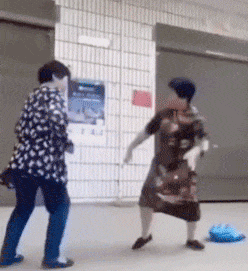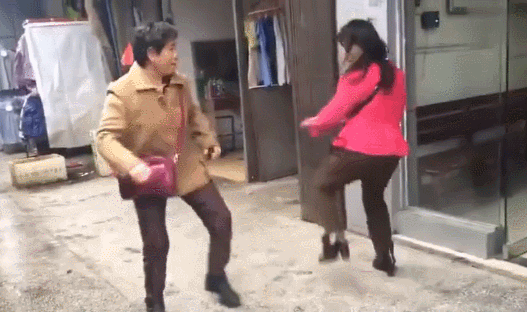Screenshots from the movie 九品芝麻官 [Hail the Judge], directed by 王晶 (Win's Movie Productions, 1994), 1:08:42 - 1:08:32
If you search for "Chinese Dama"(中国大妈) on Bilibili, the first result would probably be "Chinese Dama’s Quarrel - An Intangible Cultural Heritage That’s Fading Away"(大妈吵架——一种即将逝去的非物质文化遗产). This video was uploaded in July 2020 and has already received more than 8 million views, bringing back the marginalized "Chinese Dama" into the spotlight, though in an entertaining way.
无云哥哥. "大妈吵架—— 一种即将逝去的非物质文化遗产". Bilibili Video, 2:25. March 13th, 2021. https://www.bilibili.com/video/BV1KZ4y1w7BQ/?spm_id_from=333.788.recommend_more_video.-1
In the widely distributed video "Chinese dama quarrel,” two middle-aged or elderly women fight. Or rather they jump up and down to express anger, slap hands to attract people’s attention, jab with their fingers to deter each other (in a way that’s remindful of Voldemort's Avada Kedavra killing curse), and repeat words to assert their dominant position. Finally, at the right moment, they fall to the ground to show their weakness, let the onlookers know what happened and ask for "comments."
What kind of social group does the term dama refer to?
If we think about this video, we are prone to ask: Why did it go viral? Is it just because it is funny? To answer these questions, we first need to think about which part of society damas belong to. According to a 2015 study, "most damas live in silence in villages and small towns."1 They thus "received their education at a time of political turmoil in mainland China, especially during the Cultural Revolution."2 The poor quality of their education has prevented them from acquiring cultural knowledge and the etiquette considered proper in modern urban society. From a spatial perspective, most of them are so-called "left-behind women" living in the countryside. Because they are too old to go out to work in modern cities in the eyes of urban employers, they have to work as farmers or engage in non-productive activities, e.g., taking care of the elderly or children. Therefore, it can be said that damas constitute a marginal group excluded from modern social interaction and production.
Who constructed this image?

The figure of the “fighting dama” has been created by the young people who watched the video on social media. Most of those active on Bilibili and other online platforms have received at least nine years of compulsory education, live in towns and cities, and most of them have relatively stable jobs. They also have a very different way of interacting and communicating, which rarely involves taking matters into their own hands. Therefore, young urban-dwellers looking at countryside damas is a process of socially marginalized groups being at once consumed and ignored.
Entertaining or stigmatizing?

The memefication of the dama figure is, on the one hand, entertaining and, on the other hand, stigmatizing. Many people have witnessed scenes of damas’ fighting in the street or in the neighborhood and consider it vulgar and embarrassing. Once transposed on video platforms, this scene becomes a “cultural landscape with Chinese characteristics” to be watched. It is entertaining precisely because the fight scene is perceived as being vulgar, ugly, and clumsy. Thus, the phenomenon of fighting damas viral videos can be interpreted as a byproduct of growing inequalities in Chinese society.
References / To go further
李若建,"留守与退场:‘中国大妈’的人口学分析." 中山大学学报(社会科学版) ,2015,5: 150.
李若建,"留守与退场:‘中国大妈’的人口学分析." 中山大学学报(社会科学版) ,2015,5: 152.





